Like many American Christians, I have always dreamed of going to Israel and walking through the land of the Bible. Two months ago, a dear friend from college spontaneously called and invited me to join her on a last-minute work trip to Israel. Five days later, I was on a plane to Tel Aviv.
I found the whole ten days in Israel to be amazing, wonderful, and overwhelming in all the cliché ways writers try to avoid. I loved the food, loved the people, hated the crowds, questioned my preconceived ideas, etc. It took me several days to write out my thoughts and a few more weeks to decide what I wanted to share with the world. The following post is a small sample of my experience in the Old City of Jerusalem.
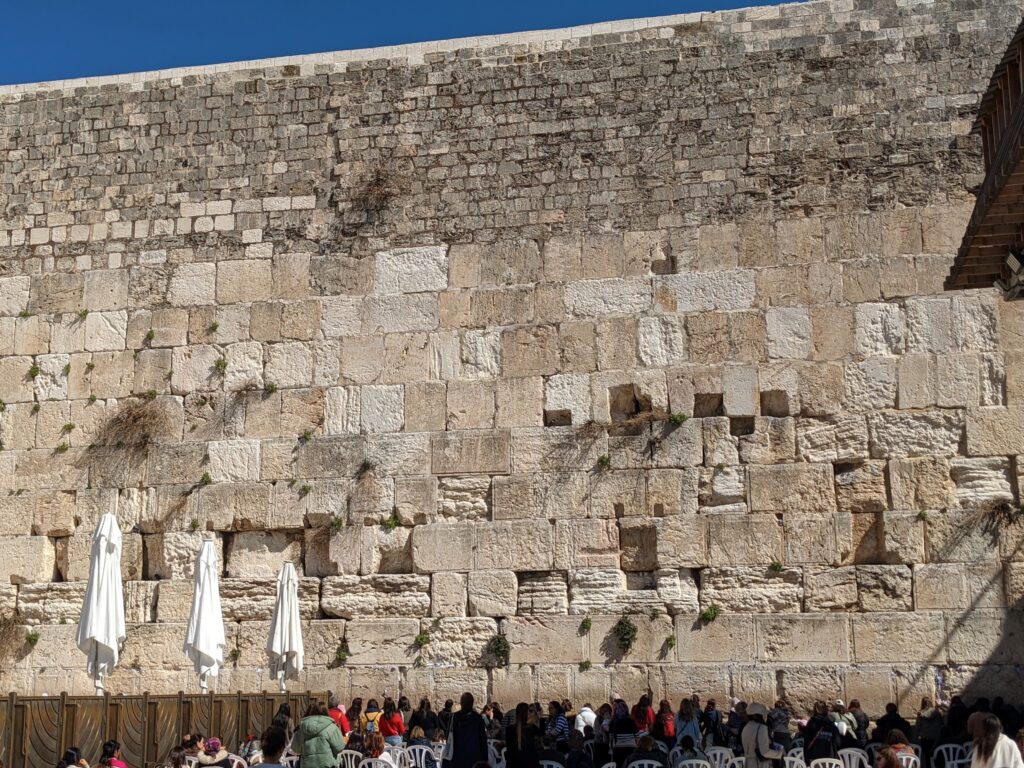
When people ask me what I liked best about Israel, what was the most meaningful thing for me, I think about the dipping my hand in the Jordan River, walking through the synagogue at Capernaum, strolling along the beach in Tel Aviv, seeing Masada, floating in the Dead Sea, eating St. Peter’s fish along the Sea of Galilee. But all of these experiences easily come in secondary to the awe of praying at the Western Wall.
The first time I approached the Western Wall, the remnants of the Jewish Temple in Jerusalem, I came alone.
I had spent the chilly February afternoon walking around the Old City with a friend leading a Danish tour, but after a few hours, I decided to break off from the group and find the iconic “Wailing Wall.” As I passed through the security checkpoint and onto the plaza, the physical presence of the Wall, representing so much history and promise, drew me towards its ancient stones while a thousand lines of scripture and story and song echoed in my heart. And like so many who had come before, I could not believe I was there.
It did not see many large tour groups that day. Instead, I saw, on the women’s side, Jewish women of all ages standing before the Wall. One young woman in a long black skirt and sweater held a book to her face and rocked back and forth. Other women sat silently in plastic lawn chairs, reading from prayer books. There were women with strollers, young children, and others too old to stand for long periods.
Lines of women crowded along the Western Wall, several people deep, so I held back, watching. They pressed their palms on the ancient Wall, sometimes kissing it, sometimes tucking bits of paper into the stuffed crevices. And as I watched, I felt I was standing at the base of one of the most precious spots on Earth, a holy place of prayer.
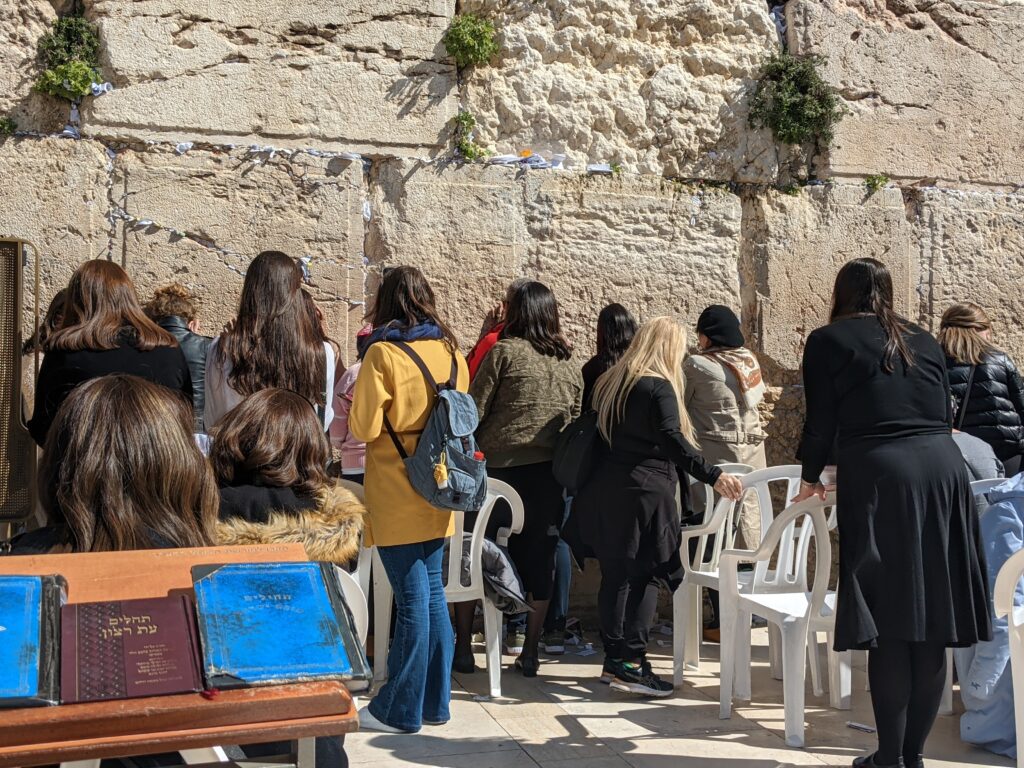
Jews consider these written prayers sacred, and when the space between the ancient foundation stones fills with prayers, they are removed and buried with the same dignity a retired holy scroll is handled. It’s foreign to my sense of casual religion, where Evangelical Christians approach God with the least amount of formality. One young man in my church often prays, “Hey God,” or “Hey, Daddy God.” It always surprises me, but it doesn’t offend me. It’s his version of remembering he has a Heavenly Father who is generous and loving, available. It’s born of intimacy and affection, two sentiments easily found in the Hebrew Bible and New Testament.
I could only stay briefly, so I planned to return with my traveling companions a few days later. The second time I visited, I scratched prayers onto a loose piece of paper ripped from a tour book I was reading and took my turn tucking them into the Wall. I placed my palms on the Wall, warmed by the afternoon sun, and emotion welled up from my soul to my eyes.
This place, so precious, this Temple, lost. Your Presence. Something close to grief bubbled up in my soul. Grief and longing. Come, Father. Come to Your People. We need you. Peace for Jerusalem.
I wrapped the scarf from my neck over my blond hair, partly out of respect and partly because the afternoon sun was beating down hard. I knew I was an outsider, but I felt welcomed into the experience, maybe more than I should have.
And I think that is a bit of what it is like to love the God of the Jews and remember that I will only ever be a guest in the Jewish homeland. I am part of the self-identifying grafted branches, sucking into the nutrients of the living trunk, the root of Israel. I love Israel because I love Jesus, who fulfills the Torah in every way. And I cannot express how exciting it is to read the Hebrew Bible and the Old Testament, side by side with the Gospels, and catch glimpses of them both in modern Israel. It’s why people like me come here every year, and as I press my palms on the Western Wall, I feel it in my soul.
Church of the Holy Sepulcher
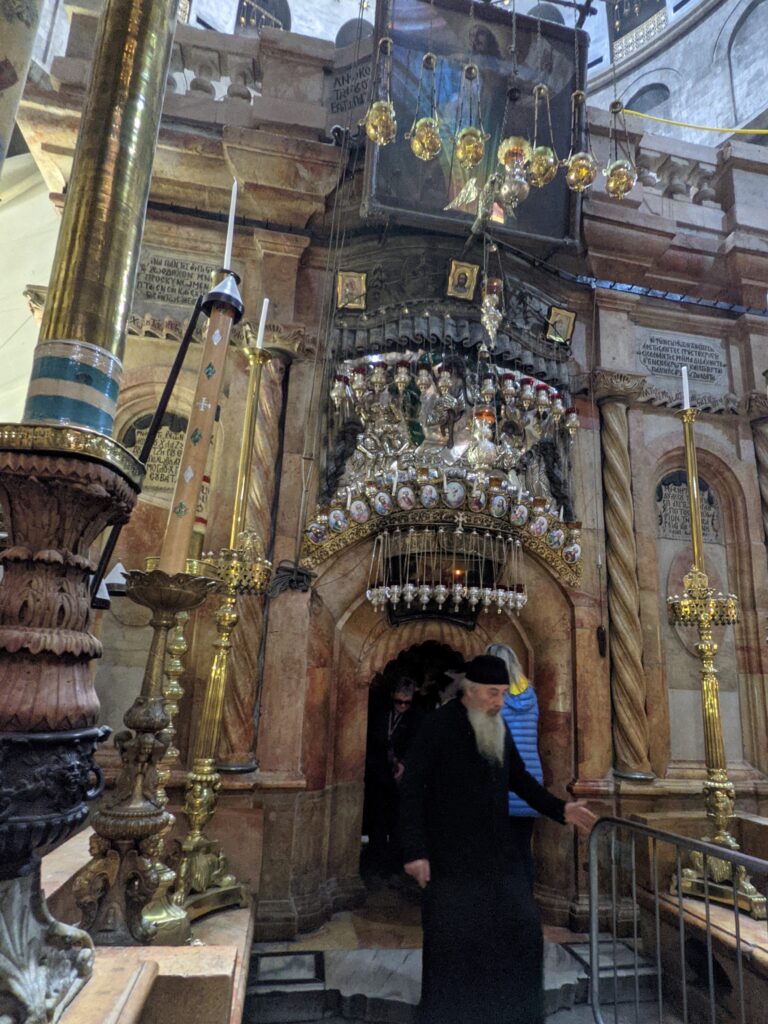
The Church of the Holy Sepulcher, a primary pilgrimage site for people of my religion, felt less holy and authentic. I appreciated being in the church building, a complicated fortress of chapels and rooms, built and rebuilt by generations of Christians since Constantine, managed by church denominations with different art forms and customs. I found the Byzantine artwork beautiful and fascinating, different even from the cathedrals I have experienced in Italy and other European countries.
Walking through the church, I wished my daughter Micah was there. Her love for church history has fed her a wealth of information on ancient church artwork, and I am sure she would have seen things hidden from me, bringing value out of a confusing experience.

But the pushing crowds, clamoring for a moment to touch the ground where the cross went into the ground or enter the decorated shrine above the tomb where Jesus was laid, pulled me out of my sense of awe and wonder. The unwavering claims of authenticity ignited my journalistic cynicism. How do we know that the actual cross was placed here? What evidence exists that this was the rock Jesus’s body was laid on, and even if it was, does that matter?
It mattered to the people around me, so I moved out of the way to make room for their faith.
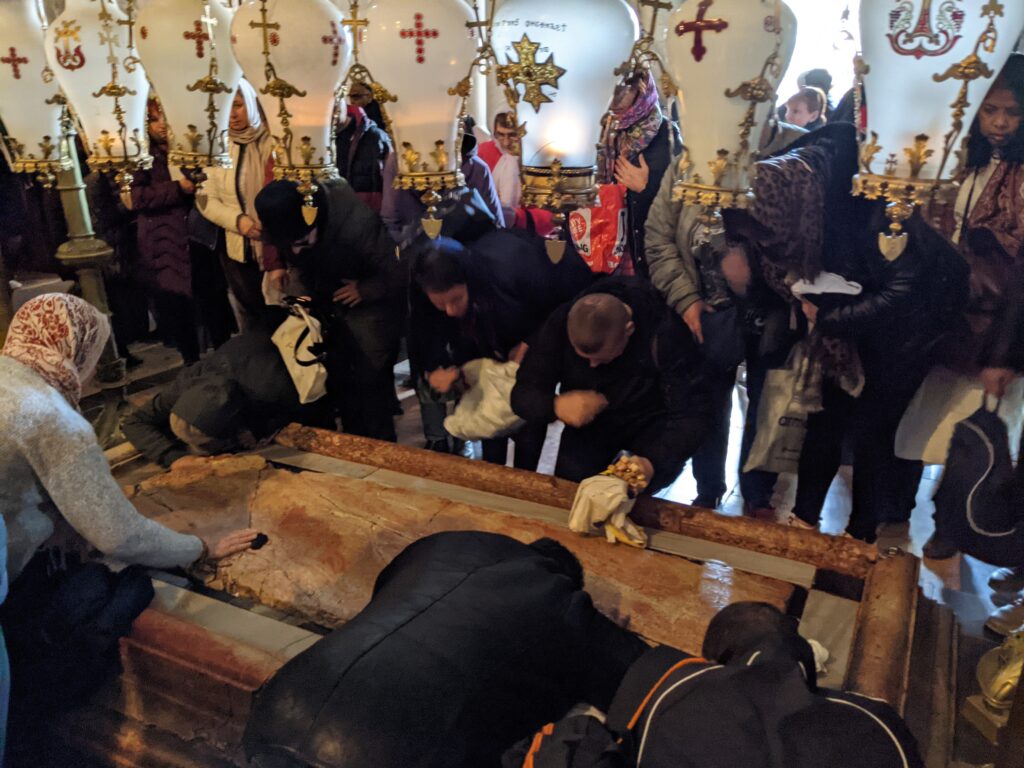
Evangelicals have an awkward relationship with spiritual presence in physical objects. The Reformation distilled religion around beliefs, intellectual statements, while leaving us with sacramental practices that can feel hollow, especially after the nondenominational movements of my parents’ generation further stripped them of their theologically rich liturgy. It is not surprising that so many evangelicals today feel conflicted about physical rituals like baptism and communion. I think this is changing, however, as churches are placing more emphasis on liturgy and even the Eucharist. I’ve heard one evangelist describe it as a Communion Revival, a renewal in our corporate understanding of what it means for the bread and wine to be the Blood and Body.
In the last few years, I’ve tried to approach my Catholic brothers and sisters with an open heart, assuming that my religious background may have tainted my understanding of their sacred traditions.
But to be honest, the culture of the Holy Sepulcher still felt foreign to me. It left me questioning the concept of pilgrimage as a holy discipline. God commanded the Jews of the Hebrew Bible to return to Jerusalem, to the Temple. There is no theological debate about that. But Christians were not given the same command. In fact, Jesus gave the opposite instruction. As he prepared to ascend into Heaven, he commanded his disciples to “Go into all the world.” He said nothing about traveling to Jerusalem to pray at the sight of his crucifixion.
Garden Tomb
The Holy Sepulcher, however, is not the uncontested sight of Jesus’s death and burial. Fifteen centuries after Constantine’s mother discovered the cross in Jerusalem, British archeologists determined that a site outside of the Old City was more likely to be Golgotha. There was even an empty tomb nearby. And now tourists can visit that sight, peacefully arranged around a sunny garden, within walking distance from the crowded Via Delrosa. There is no shrine or busy church built above the site. The space is left open to the elements, making it easier for someone like me to imagine the tomb on Easter morning.
When I was there I could imagine light shining out of the empty tomb and Jesus meeting Mary Magdalen among the olive trees. Mary, he said, and she recognized him. I could imagine that interaction outside the Garden Tomb.
But despite its peaceful outdoor setting, safe from two millennia of Christian constructs, the Garden Tomb is still in the middle of a modern city. Golgotha, which means the place of the skull, has an uncanny resemblance to a skull face, as all the tour guides point out with black and white posters, pointing to the hillside’s caverns that look like empty eye sockets. But this Golgotha is located squarely in modern East Jerusalem, overlooking a bus terminal. Where there should be pilgrims kneeling at the foot of the cross, there are buses and weary travelers making their way further out of the city into the politically contentious West Bank.
As frustrating as that seems, it also makes sense. The gospel has always been messy and inconvenient. Jesus’ followers did not use the cross as a symbol until generations after his death. Why should Golgotha be anything more than a hill overlooking a bus station and a Muslim Mosque? If the cross cannot meet us in the middle of our busy, ordinary lives, what is it? As soon as I think this, I immediately wonder if I am like my young friend saying, “Hey, Daddy God.” But in the end, that is what it is. Abba means daddy, and the message of the gospel is as much modern and relevant as it is ancient and romantic.
And that is what it means to be a modern traveler trying to eek meaning out of a complicated, contested Holy Land. If anything, the less holy the official sites feel, the more they testify to the incarnation. John says, “The word became flesh and came to dwell with us,” the message of the gospel is that Jesus dwells with humans in human flesh, in incense-filled cathedrals as well as East Jerusalem bus terminals. So from a devotional perspective, it doesn’t matter if the tomb is inside the Old City or not. They are both empty. And it doesn’t matter if I can emotionally connect or not. As the Apostle Paul says, I am saved because I believe with my heart that God raised Jesus from the dead, and I speak with my mouth that Jesus Christ is Lord.
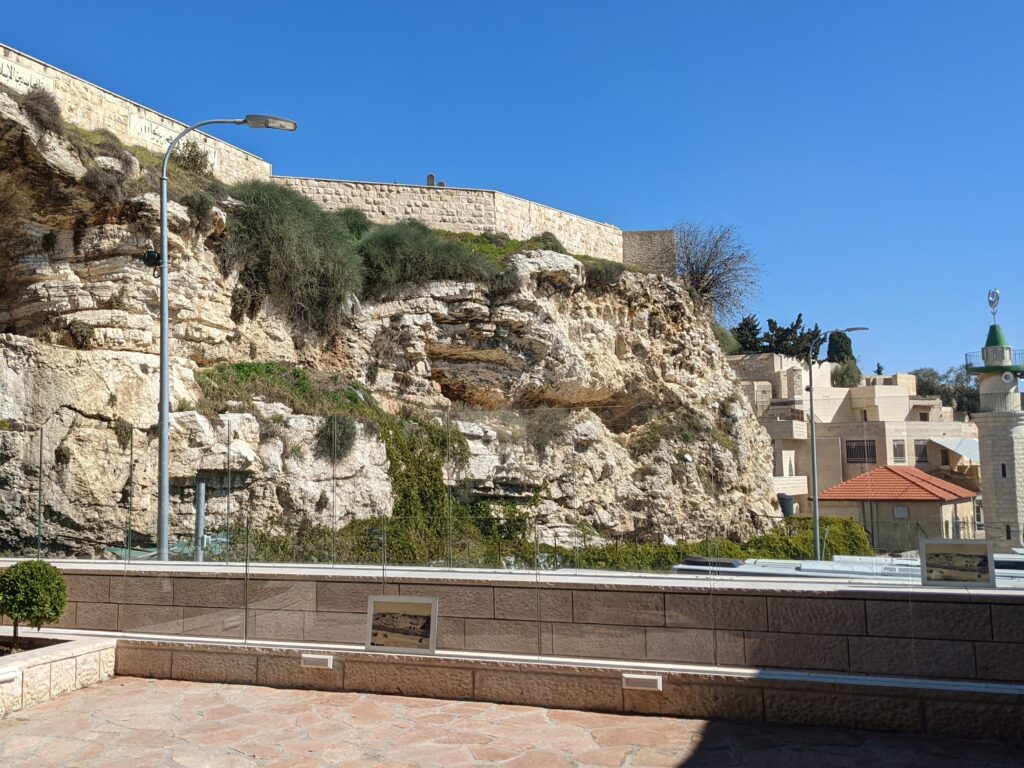
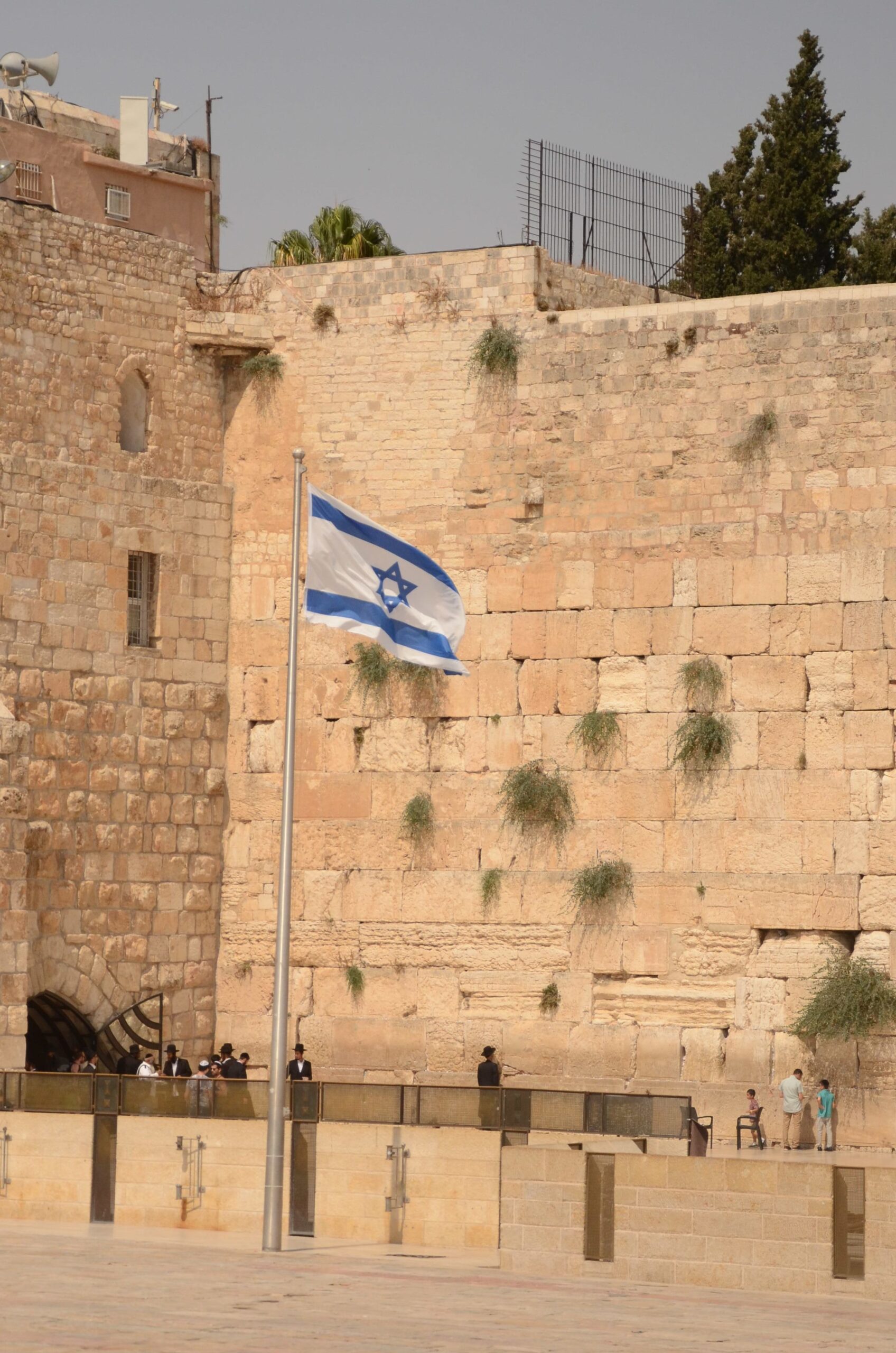
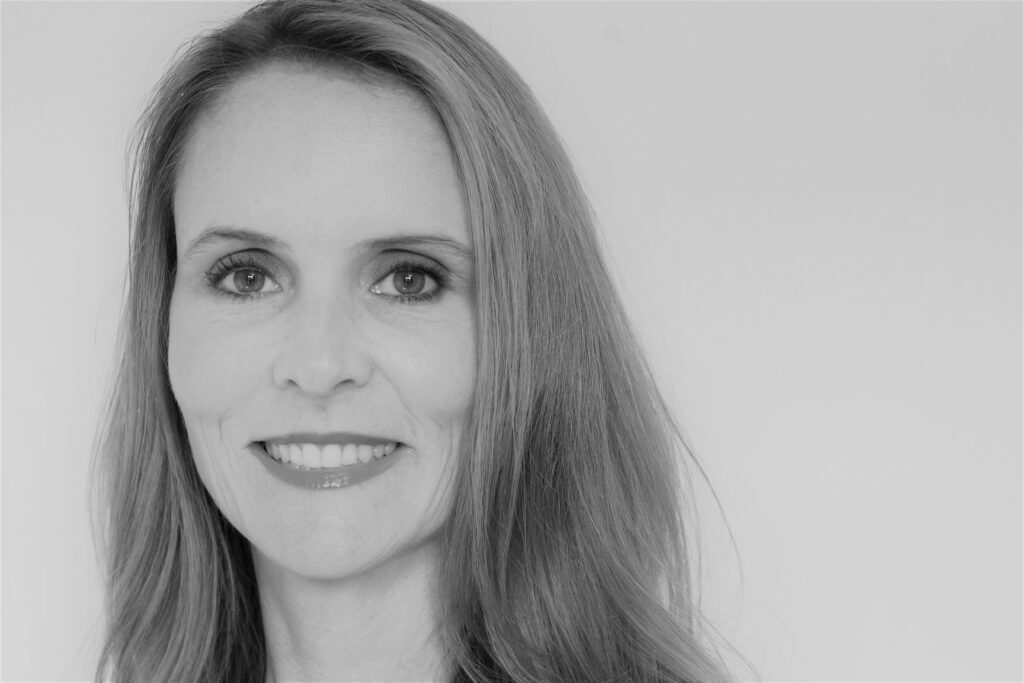
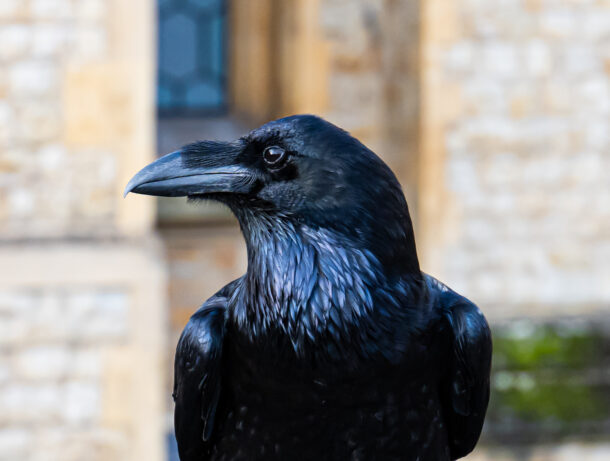
I felt like I was with you. ❤️
Wow.. thank you for capturing these heartfelt moments so masterfully.